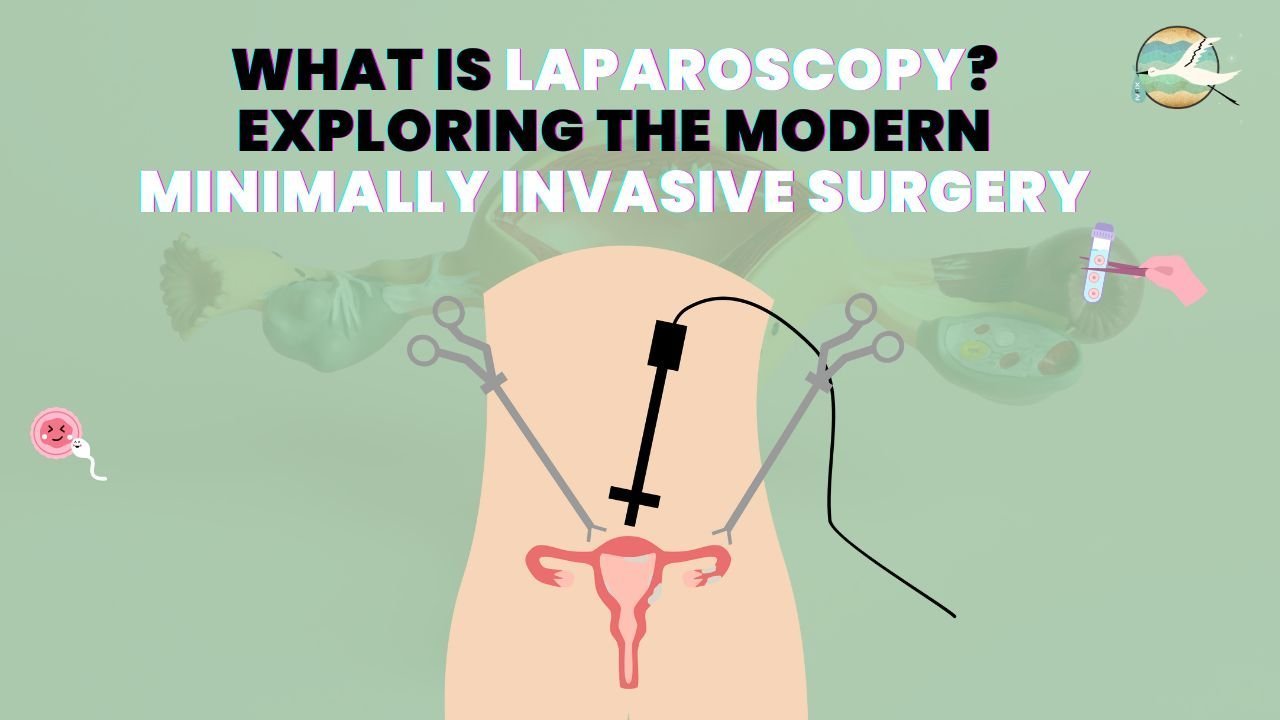Learn all about laparoscopy, a minimally invasive surgical procedure that is changing the way healthcare is provided. Everything you need to know about laparoscopy, including its advantages, techniques, recovery, and more, is included in this thorough reference.
Table of Contents
Laparoscopy is a remarkable example of innovation in the world of modern medical wonders. Laparoscopy, also known as “Minimally surgery,” has altered the nature of surgical procedures. Laparoscopy’s complexities are thoroughly explored in this article, which also clarifies its uses, benefits, and other aspects. Join us as we investigate the world of minimally, whether you are a medical enthusiast or a patient seeking knowledge.
What is Laparoscopy?

Your doctor may use laparoscopy, a type of diagnostic surgical procedure, to examine your reproductive and abdominal organs inside your body. The procedure can also be used to obtain samples of tissues (biopsies) for testing. Your abdomen is cut to pass a laparoscope, a thin tube resembling a telescope. Your doctor can look at the outside conditions of your: Uterus, Ovaries, Fallopian tubes, Liver, Pancreas, Gallbladder, Spleen, and Stomach.
If X-rays and ultrasounds are unable to identify the root of your condition, your doctor may advise a laparoscopy. A laparoscopy may be used by your doctor to:
- Check out a tissue mass.
- To relieve abdominal and pelvic pain, identify its source.
- A pelvic inflammatory disease or endometriosis must be confirmed.
- Search for other infertility causes, such as fallopian tube blockage.
Understanding the Procedure

During a laparoscopic procedure, the surgeon makes a few small incisions in the abdominal wall, typically around half an inch in size. Carbon dioxide gas is introduced through one of these incisions to create a working space, which helps to lift the abdominal wall away from the organs, providing a clearer view and more room to maneuver. A laparoscope, a thin tube equipped with a light and camera, is then inserted through one of the incisions. This camera allows the surgeon to see the internal structures of the patient on a monitor in real-time, guiding their movements throughout the procedure.
Through the other small cuts, specialized surgical instruments are inserted, allowing the surgeon to perform a variety of tasks such as cutting, suturing, and removing tissue or organs as needed. While watching the monitor, the surgeon navigates and operates within the abdominal cavity with these instruments.
A wide range of medical and diagnostic procedures, such as gallbladder removal, appendectomy, hernia repair, gynecological operations like hysterectomy and ovarian cyst removal, and others, are performed using minimally. In comparison to traditional open surgery, minimally invasive surgery frequently results in less postoperative pain and discomfort, shorter hospital stays, and quicker recovery times for patients.
As a result of offering a less invasive option for diagnosing and treating a variety of abdominal and pelvic conditions, minimally is a sophisticated surgical technique that has revolutionized the field of surgery. In many medical situations, it is the preferred option for both patients and surgeons due to its advantages in terms of decreased pain, accelerated healing, and smaller scars.
Applications of Laparoscopy:
Laparoscopy is used in a variety of medical specialties, such as:

- Gynecology: To diagnose and treat problems including endometriosis, ovarian cysts, and fibroids, minimally is frequently employed.
- Gastroenterology: It assists in performing weight-loss procedures, evaluating the digestive tract, and treating illnesses like appendicitis.
- Urology: Surgery on the kidneys, and bladder, as well as procedures for ailments such as enlarged prostate, are made easier by minimally.
- Orthopedics: It is used in joint procedures to heal damaged ligaments, among other things.
Also Read: What Is the Reason for Having IVF Treatment?
What are the Benefits of Laparoscopy in IVF?
In the world of IVF, laparoscopy has a special place since it offers a number of advantages that improve the course of fertility treatment as a whole. Let’s look at some of the particular benefits of including minimally in IVF procedures:
Accurate Diagnosis: The accurate assessment of potential fertility-impairing conditions such as endometriosis, ovarian cysts, and tubal obstructions is made possible minimally. With such a precise diagnosis, reproductive treatment will be specifically targeted.
Effective Treatment: minimally not only aids in diagnosis but also allows for simultaneous treatments of problems at the same surgery. As a result, fewer procedures are required because the process is reduced.
Optimized Ovarian Stimulation: Laparoscopy can help with ovarian drilling for women who suffer from problems like PCOS. This promotes effective IVF outcomes by controlling ovulation.
Improved Egg Retrieval: minimally provides a different strategy when transvaginal egg retrieval is difficult. Women with atypical anatomy may benefit the most from this.
Enhanced Uterine Assessment: minimally provides a clear view of the uterine lining, allowing fertility specialists to evaluate its condition. This assessment ensures an optimal environment for embryo implantation.
Minimized Scarring and Discomfort: The low scarring and less postoperative discomfort associated with minimally improve the patient experience as a whole.
Quicker Recovery: Due to the less invasive nature of laparoscopy, patients can return to their regular activities sooner and spend less time in the hospital.
Reduced Complications: minimally offers a safer beneficial alternative by minimizing effects with less tissue manipulation.
Higher Success Rates: Higher success rates in IVF treatments are a result of laparoscopy’s precision and capacity to address underlying problems.
Long-Term Cost Savings: The benefits of minimally, such as shorter hospital stays and speedier recovery, can offset initial costs, even though they may be higher.
By providing patients with a thorough strategy that includes both treatment and diagnosis, the integration of minimally into IVF protocols highlights the progress of reproductive therapies. minimally is still a vital technique for assisting people in realizing their parental ambitions as medical technology develops.
Is laparoscopy safe?
The procedure of laparoscopy is very safe. This procedure has the advantage of enabling a precise diagnosis of your condition by your healthcare professional. Three out of every 1,000 procedures on women result in complications. Complications that could arise include:
- Injury to the blood vessels and nearby organs.
- Bleeding.
- difficulties with anesthesia.
- Infection.
- abdominal wall inflammation.
- a blood clot that might travel through your bloodstream and end up in your lungs, pelvis, or legs.
- It is extremely rare to develop a blood clot that could move to your brain or heart and cause a heart attack or stroke.
Before your procedure, discuss any concerns you may have with your healthcare provider. Your provider will be able to inform you of the potential complications and explain your risk for these issues.
Laparoscopy For IVF

Laparoscopy for IVF is a minimally invasive surgical technique used to diagnose and address fertility-related issues. It helps identify conditions like endometriosis, ovarian cysts, and tubal blockages that could affect IVF success. minimally is particularly valuable in cases of PCOS and can aid in egg retrieval and assessing the uterine lining. Its benefits include smaller incisions, less pain, and quicker recovery, enhancing the IVF experience. However, its necessity depends on individual cases and expert recommendations.
Is Laparoscopy Surgery Painful?
Compared to open surgery, laparoscopy surgery typically results in less postoperative pain. For many patients, healing is more comfortable because of the smaller incisions and less tissue manipulation.
After a laparoscopy
After your laparoscopy, you can typically leave quickly. You must wait until your anesthesia has worn off and your doctor has confirmed that you aren’t suffering any negative effects from the procedure. You will recover at home for a few days after your laparoscopy.
How can I recover from a laparoscopy at home?
It’s important to keep a few things in mind as you heal at home following your laparoscopy. These recommendations include:
- After surgery, avoid driving or consuming alcohol for at least 24 hours.
- You can take a bath at any time after surgery.
- You can remove the bandage the morning after the procedure. After surgery, sterile strips, which resemble tape, can be taken off two to three days later.
- After surgery, you can usually start working again three days later. Please request a letter from your doctor to excuse you from work at your pre-operative appointment if you require one.
- If your urine is green, you shouldn’t be alarmed. A blue dye may have been used to check the openness of your fallopian tubes.
After a laparoscopy, can I expect vaginal bleeding?
Up to one month after minimally, vaginal bleeding is typical. After surgery, many women experience their next regular menstrual cycle four to six weeks later. You might experience heavier bleeding and more discomfort than usual when your regular cycle resumes.
Check to see if your condition has improved after two to three menstrual cycles to determine whether the minimally was successful.
FAQs
Q: What conditions can be treated using laparoscopy?
A: Gallstones, hernias, reproductive problems, and other disorders can all be treated with laparoscopy.
Q: Is laparoscopy safer than traditional open surgery?
A: Generally, laparoscopy offers a safer alternative due to reduced risks of infection, less blood loss, and faster recovery times.
Q: How long does it take to recover from a laparoscopic procedure?
A: Recovery times vary, but patients often return to light activities within a week and experience full recovery within a few weeks.
Q: Are there any risks associated with minimally?
A: While minimally is generally safe, risks like infection, bleeding, and organ damage exist, although they’re rare.
Q: Can everyone undergo laparoscopic surgery?
A: Laparoscopy is not appropriate for everyone. The appropriateness of a procedure is determined by factors like general health, medical history, and treatment complexity.
Q: Are the results of laparoscopy permanent?
A: Long-lasting benefits from laparoscopic surgeries can be achieved, but they also depend on the underlying ailment and the patient.
Conclusion
With simpler-to-use, safer, and more effective operations thanks to laparoscopy, modern surgery has undergone a revolution. It’s understandable why minimally is still changing the healthcare landscape given its many benefits and applications in a variety of medical specialties. Laparoscopy is a monument to human ingenuity, improving patient outcomes and raising the standard of healthcare globally, whether you’re a medical practitioner or just interested in medical developments.




